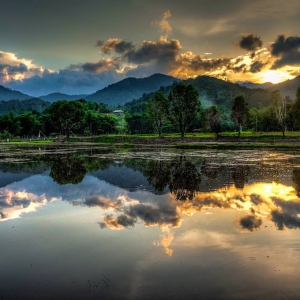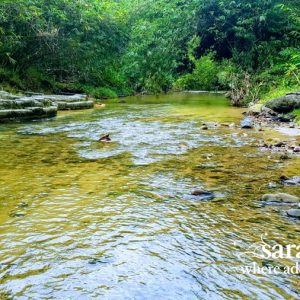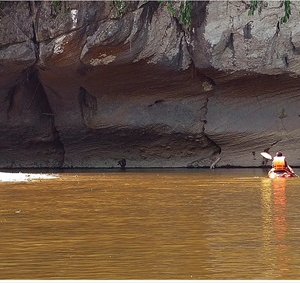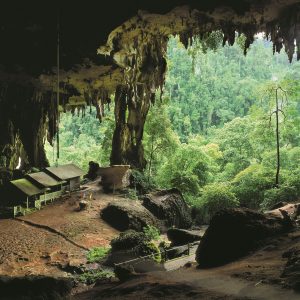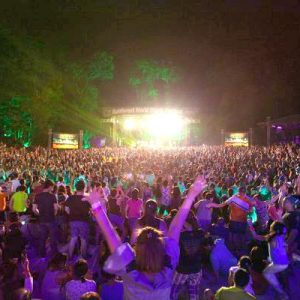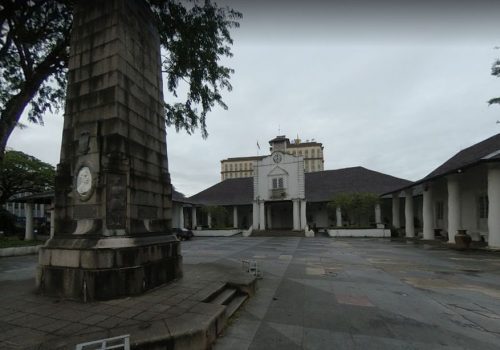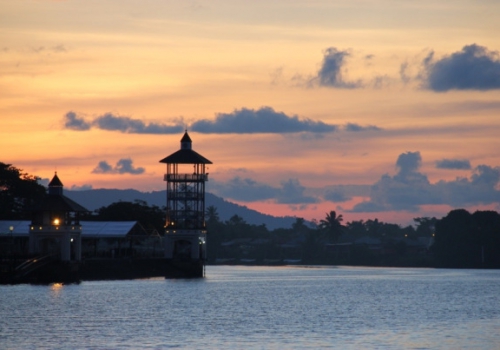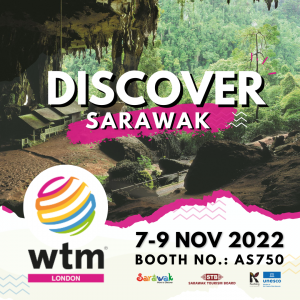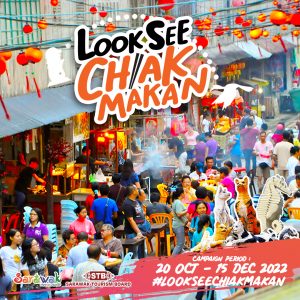Go Local: The Sarawak Experiences you shouldn’t miss
Every traveller is looking for that authentic tourism experience; not a tourism experience at all, but instead an authentic local one. The whole point of a holiday is to step out of our own humdrum workaday existence into an entirely new headspace. The ultimate question is: how can we access another culture and lifestyle in just a short space of time?
Here is your answer: a full rundown of all the greatest Sarawak experiences on offer. It is a glimpse into how we work and how we play; how we welcome and how we get on together; how we shape the landscape around us and, of course, how it has shaped us. Of course, every culture is unique and unusual but Sarawak can be such a sideways step that sometimes it is good to have a guide; even better, a local one!
So, if you want to have a truly Sarawak experience, here is an idea of what you can do to see how we Sarawakians truly experience it.
- Climb every mountain
- Ford every Stream
- Mess about in a boat
- Wait for Wildlife
- Eat the jungle
- Raise a glass
- Mix your metaphors
- Get Spiritual
- Dig up history
- Meet the Brookes
- Join a community
- Get Festive
- Sing your heart out
- Get decorative
- Marvel at the monsoon
1. Climb every mountain
The spine of Sarawak is a series of imposing peaks, dropping down to Indonesian Kalimantan on one side and Sarawak on the other, as the state rises in stages from its coast up into forested hills and finally, the mountainous highlands behind. So, be prepared – every Sarawak jungle hike involves a pretty serious slope and, of course, the ultimate reward of the impossible view from the summit.
For the truly hardy, there are the Highlands. The Mulu Pinnacles, for example, are a Sarawak experience not for the faint-hearted. Widely reputed to be one of the most difficult trails in Malaysia, the pinnacles will keep you on your toes (literally!) as you navigate the limestone razors of rock that characterize this 3-day hike. Alternatively, for a little less huff and puff, consider the beauty of Bario, an oasis of padi fields and Sarawak culture from the Kelabit community, encircled by a ring of hills, each with their own hiking trails. Of course, as relaxing as it sounds, Bario would equally be a jumping off point for a hike to the towering, twin peaks of Batu Lawi, scaled successfully only twice on record!
For the Sarawak heritage enthusiast, several hilltops beckon. As with many indigenous cultures, the summit is often a sacred space. Mount Santubong is a source of myth and folklore, telling the story of two sisters petrified into rock for their sins. It is a scramble up bamboo ladders and scary rope climbs, but the peak is a wide-open view of the South China Seas – the magic plain to see. Mount Singai, however, is a different study in transformation. Historically the hilltop home of the Bidayuh where they defended themselves against attack, peacetime brought them down to the valley. As they converted to Christianity, their annual pilgrimage back to their ancestral home was converted too and now every hiker can follow the Stations of the Cross up its sides.
For the Sarawak history buff, take a leisurely climb up Mount Matang to an unlikely Hindu temple, a monument to the Indian workers in the Rajah’s tea plantation that once hugged its slopes. Or else, assault Bukit Sadok in Betong to relive the last stand of the Skrang warrior Rentap against the forces of Charles Brooke; the Iban armed with a captured cannon dubbed Bujang Timpang Berang (the one-armed bachelor).
Of course, with every hill – for hiking, for heritage, for history – there comes the possibility of racing rapids, leaping waterfalls, lurking caves, creeping flora and swinging fauna; everything Sarawak nature has to offer. At Gunung Gading alone, a single trail has seven waterfalls up its sides, each an opportunity for a cooling dip, as well as the peculiar Sarawak experience of the pungent stink of the world’s smelliest and most secretive flower, the Rafflesia. Or else, follow in the footsteps of world-famous naturalist Alfred Russel Wallace up Mount Peninjau to see the natural features that he so lovingly described in his travel classic, The Malay Archipelago.
You’ll never run out of hills to climb in Sarawak and they all have their own appeal. In the end, you can even head for the Hills (the shopping centre in central Kuching, that is!) and tackle the wall, where you can climb every mountain away from the tropical heat!
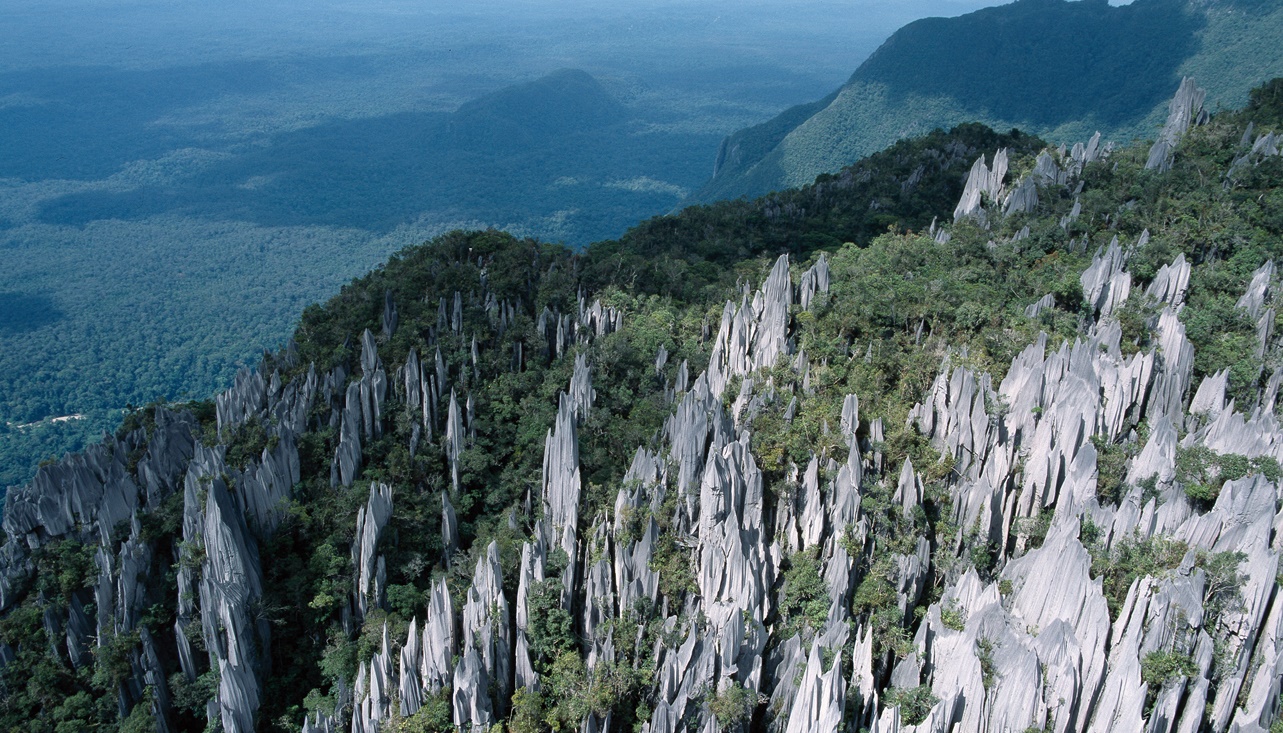
The Mulu Pinnacles
2. Ford every Stream
Nothing beats the Sarawak experience of a swim in a Sarawak river. The state is intersected by an immense network, from mighty waterways to many, many mini streams and tributaries. Almost every Sarawak settlement stands next to one and almost the favourite pastime in each is the mandi sungai (river bath). Often communal, the entire kampung (village) will troop down to a section of the stream and simply sit. Some will pull out their soap and lather themselves to within an inch of their lives, allowing the icy water from up in the mountains to wash away the dirt and their day at the farm. Whether you choose a wide stretch of water or the rush of a nearby waterfall, the result is the same: a slow, steady return to the rhythm of Sarawak nature.
Of course, this is usually accompanied by the obligatory barbecue, often including food from the forest itself. Sometimes you have to build your own pyre on a pebble beach, or else find one of the many campsites already set up with pits provided. Each has its own allure and provides its own unique Sarawak experience. The Adis Buan ‘resort’, for example, (be warned, they use the term resort loosely!) offers the pre-made barbecue package but the real magic is in the rows of Melaleuca trees that line the banks, unfurling long curls of their bark to reveal their dusty, crimson skin beneath – Sarawak’s true technicolour. Equally, you can test the length and breadth of the Sarawak River. As you travel up Jalan Puncak Borneo, it is a journey back in time along the life of this mighty river that gave the state its name. Each kampung along the way provides an unusual aspect – the water’s steady gait, the running rapids, the carved limestone sides – as it rises up into the mountains to the three-storey waterfall near Kampung Sadir at its source.
For an alternative dip, Sarawak has hot springs. Although this might seem counter-intuitive in a tropical climate, it is an equally edifying Sarawak experience. Annah Rais is a study in contrast as the warm springs bubble up into the chill of the river around it. But for the truly immersive encounter, head to Panchor. Choose dawn or dusk, whichever suits, and submerge yourself in the sulphurous steam as the sun completes its round and the Sarawak nature around you noisily transitions from one shift to the next. Whatever your choice, bring a sarong wherever you go because, in Sarawak, you are always going to want to get your feet wet.

Annah Rais
3. Mess about in a boat
With many rivers come many boats and, in fact, the links are so close that many locals look like they were born in one. With perfect precision and balance, they can hop from ship to shore and still swing a fishing net with their spare hand. Boats were the preferred method of transport until late into the 20th Century, and while the roads have gone in around the state, the fondness for river travel remains unabated, even if it is now mostly for fun and fishing.
The longboat is the upriver staple. Traditionally 12 feet long and 3 feet wide, just enough space for one seat, these are the camels of the rainforest’s rivers. Often travelling in convoy, with a huge hump of baggage in amongst the passengers, they are an open-air, white-knuckle ride, racing at speed round any obstacles, all to the earthy growl of an outboard motor. The edge of the boat just skims the surface of the water; so close indeed that icy drafts will often splash over the sides, soaking the occupants within. You simply haven’t lived until you’ve ridden a longboat.
For those who want to get even closer to the water, if that seems possible, there is the option to travel under your own steam. Banana yellow kayaks have become the new Sarawak craze and, despite the startling colour, the ride is serenity itself – a slow paddle in the still, calm of Sarawak nature. Alternatively, you can even swim under your boat in one of Sarawak’s many dive spots. For a more frenzied event, the annual Padawan Raft Safari is an epic adventure. Four passengers sitting on several lengths of bamboo lashed tightly together and only a stick to steer with; the crashes, splashes and consequent hilarity are to be expected. It’s only when you see the local elite teams pass you by – an exercise in precision – that you realize it is entirely possible to get up some serious speed.
In reality, watching the locals do water in the way that only they can is often enough of a Sarawak experience. The Sarawak regatta in Kuching and the Baram regatta in Marudi were originally instituted as part of peace-makings between warring indigenous groups; an alternative source of score-settling to the taking of heads! But following the colourful boats competing to be head of the river is still exhilarating. Head up to Kapit for the annual powerboat-racing extravaganza; in fact, the ride in an express boat from Sibu, through the petrifying Pelagus rapids, is enough of a heart-stopper in itself. In the end, from the Sarawak River Cruise to the Perahu Tambang (river taxis), there is ample opportunity for anyone seeking to mess about in a Sarawak boat!
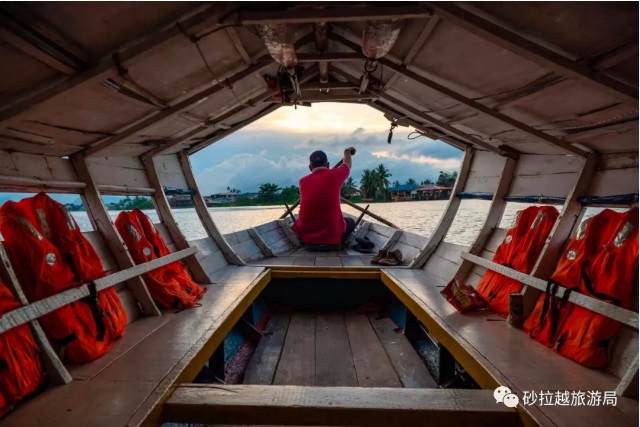
Perahu Tambang
Most travellers have at least one shared wish when it comes to their Sarawak experience: see some wildlife. It is, after all, a natural response to a place where the nature is simply unsurpassed. This wish list normally starts with landmark species, of which there are many. Hornbills, orangutans, langurs, crocodiles, clouded leopards, sun bears, eagles, lemurs: the range is immense, especially if you are open-minded. Columns of ants, clouds of fireflies, inquisitive toads, lazy pit vipers, scuttling squirrels and a vast of array of flying, creeping, crawling and slithering fauna can be an equally exciting Sarawak experience for any nature enthusiast. Even the flash of the urban monitor lizard as it slinks into a storm drain can give you that same instant of elation.
With 43 national parks, 14 natural reserves, and six wildlife sanctuaries, the chances of seeing something, and something huge at that, are pretty high. Within easy reach of Kuching, Semenggoh almost never disappoints, offering accessible orangutan to the traveller looking to tick off their list. Bako National Park is simply beautiful and if you return home without an encounter with a least a giant bearded pig or big-nosed proboscis monkey, you have been extremely unlucky. In central Miri, pairs of hornbill, who mate for life, rest on houses in Piasau Nature Reserve.
But venture further afield and the possibilities expand, along with the unpredictability. wait for Irrawaddy dolphin to swim past at just the right point. A visit to Batang Ai can promise the pleasures of Pongo in the wild. The elegance and athleticism of these orangutans as they navigate the canopy is truly awesome, but here the giant ape swings to its own beat. Mulu, meanwhile, offers the opportunity to lie in wait for the nightly mass exodus of the bat brigade and their dance of death with the forces of the peregrine falcons. Wildlife photographers flock to Borneo for months at a time, seeking that perfect shot, although sometimes the whole point is to sit by a stream and just wait for the butterflies to land.
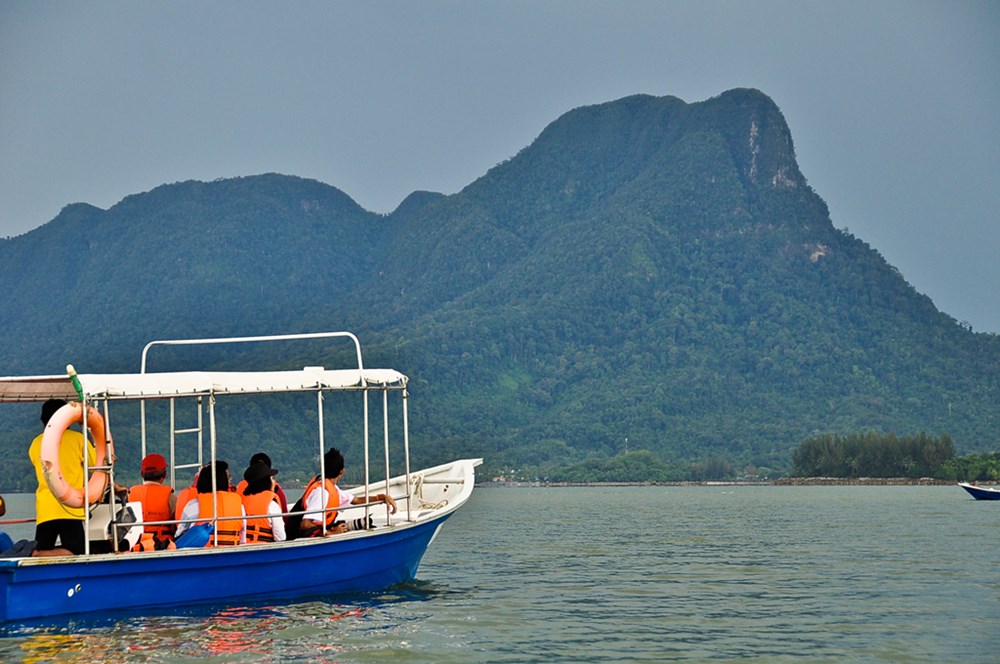
Boat trips at Santubong
5. Eat the jungle
Sibu’s Central Market is the largest covered market in Sarawak. With over 1,000 stalls on a weekday and half as many more at the weekends when the upriver indigenous people come down to trade, it stretches as far as the eye can see and sells almost anything the mind can imagine. In fact, any market in the state – from Kuching, Bintulu and Miri to small border markets like Serian and Serikin – will give you a similar Sarawak experience: a whole host of unusual ingredients in shapes, colours and consistencies never before seen or smelled. Hurry through the rainbows of tropical fish and the carnage of the meat market where the entire pig, from head to tail, is on display, to the safer vegetable and fruit section where mounds of jungle ferns, shoots and leaves, desiccated ants nests, strange herbs, mountain salt, engkabang butter and oddly-shaped fruit are a kaleidoscope of eating opportunities.
Sarawak’s most famous gross-out eating experience is, of course, the sago worm. The plump, wriggling grub is now a rare find in the local markets but still a firm favourite of the indigenous people. It feeds entirely on the interior of the sago palm and tastes like an explosion of sweet cream encased in a mildly chewy and slightly off-putting worm casing. There are several options in ‘exotic meat’ but be careful of protected species – even the wild boar, once the staple diet of the Dayak, is firmly off the menu. Conversely, you can now get a taste of crocodile, though this time it is indigenous belief which forbids it. Traditional cosmologies maintained the ancient predator to be a reincarnation of their ancestors and, besides, it is whispered that the other crocs can smell it and will come for revenge!
Overall, a stay in Sarawak is one long eating experience. With many cultures and mysterious ingredients, you can eat from day to night and never the same thing twice. Now midin and paku, both jungle ferns foraged by the indigenous people, are fried up with belacan, the famous fermented prawn paste from the Malay community. Sarawak Laksa is a classic Nyonya dish, combining Chinese noodles with coconut milk. Traditional hawker food now competes with modern international cuisine and oven-fired pizzas are as common as popiah (fresh spring rolls). You can eat your way round Asia and the world and all the way back round to Sarawak, all around the clock. So get your belly ready to eat the entire jungle.
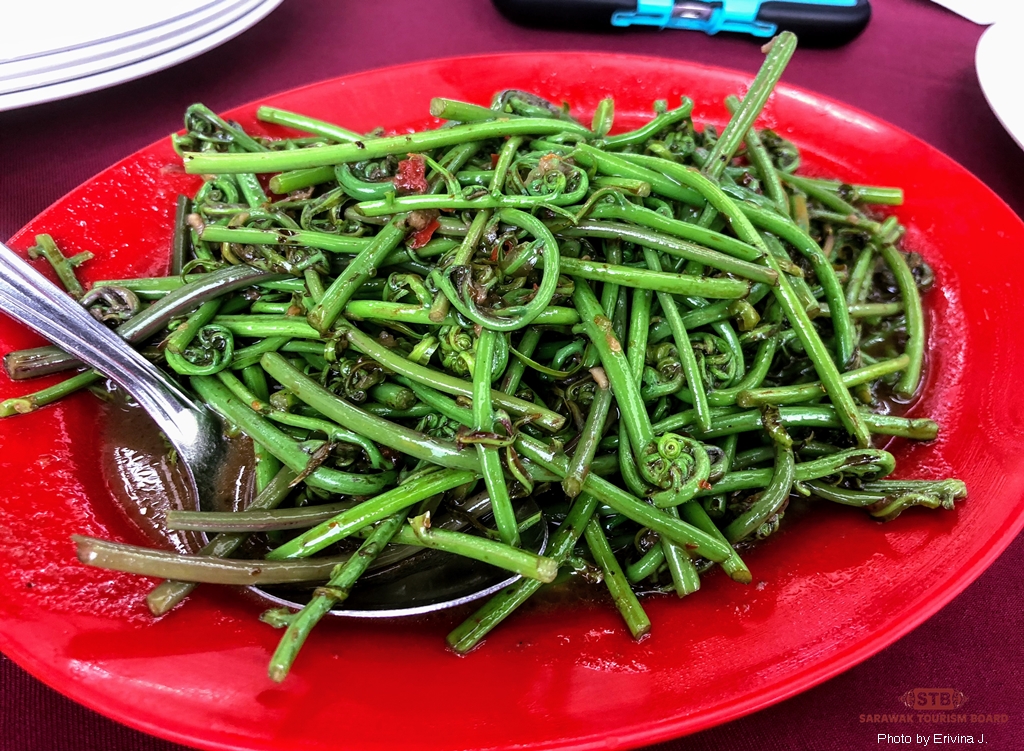
Midin
6. Raise a glass
The Sadong tells you everything you need to know about Sarawak culture. One single glass, one shot of tuak (rice wine), every person in the party takes a turn, sometimes for multiple rounds. Beware if anyone makes you take on the role of dishing out the drinks. If you ask someone to down one, they have the right to ask you to go first. After an entire circuit of the longhouse, it can get quite messy! If you really can’t take any more, touch the rim of the glass and then touch your mouth. The Sadong will ceremoniously pass you by.
But, in reality, the Sadong is a time-honoured tradition about hospitality, about sharing, about equality and also, about tuak. Sarawak’s special brew – the local equivalent of sake – is a ritualized, spiritual concoction. Made by almost every indigenous family to their own secret recipe, it comes in multiple iterations, some sweet, some dry, some even made from sugar cane. If you are lucky, you can get a taste of toddy, tapped straight from the Ijok palm. Tuak itself is so embedded that each indigenous group has its own striking toast – the OoHa, from the Iban, the tra tra tra ooha from the Bidayuh – delivered with the appropriate length, volume and energy to truly get the party started.
Tuak has, of course, made its way to town where it is being reinvented into metropolitan mixers and cocktails, which compete with the Asia-wide obsession for imported whiskies. In fact, one of the most typical Sarawak experiences is a tin of Tiger in a Sarawak kopitiam, taken from a bucket of ice, served in a tiny glass, often with added ice inside for extra measure. Whole afternoons are whiled away in increasingly noisy contemplation of life, the universe and everything. For those who don’t drink, the kopitiam is still the centre of that universe where the range of drinks, in colour, flavour and texture, is simply astounding. White White ladies, neon-pink Air Bandung, nuclear green Wheatgrass C, multi-coloured Teh C Peng special, or simply a refreshing lime juice, it is a hot country with an appropriate range of thirst quenchers. Just pick your poison and raise a glass!

7. Mix your metaphors
One of Malaysia’s most famous dishes is rojak – a salad of fruit, cucumber, jicama, tofu, anything really, all smothered in a rich, savoury, prawn-inflected sauce. It is truly an assault on the tongue. But rojak is not just famous for its flavours. The word has become an expression of language, of culture, of Malaysian life. It conveys the idea of a bizarre and incompatible assortment of ingredients that shouldn’t work but somehow do. It expresses the melting pot of Malaysia and nowhere in Malaysia is quite as mixed up as Sarawak.
With more than 40 distinct language and cultural groups, many of them entirely unique to the island of Borneo, the Sarawak cultural blends are endless. ‘Chibans’ (Chinese Ibans) hang out with ‘Eurasians’ (European Asians); groups of multi-dialect Chinese will argue loudly in Hokkien, the Kuching Chinese lingua-franca; the Orang Ulu (literally ‘upriver people’) identify readily with each other despite an enormous diversity of languages and Sarawak cultures within their number. The Sarawak kopitiam is the maelstrom of multi-cultural Malaysia, where Malay food stalls stand next to indigenous and Chinese vendors and mixed parties share the tables around them. Meanwhile, immigrant cultures are preserved in Sarawak with a purity that has been lost in their original location. The locals in the state have been meeting, mixing, mingling and marrying for so many years that we are all now simply and inescapably ‘Sarawak’.
Language alone is an exercise in intricacy. The Malay language is now believed to have originated in Western Borneo, carried out on waves of Austronesian migration throughout the archipelago and leaving Iban and Bahasa Malaysia, which is based on Melaka court Malay, with shared similarities in sound. In fact, the Sarawak Malays have their own dialect and so deciding which one to learn is not as simple as it seems! Numerous Chinese dialects, some no longer common back in their country of origin, still survive in Sarawak providing all kinds of comedy potential as one dialect’s pronunciation of a perfectly innocent word ends up absolutely filthy in another. Bidayuh, just to add to the confusion, consists of at least seven mutually unintelligible languages and so some Bidayuh speak to each other in Malay!
So how does this become a Sarawak experience? First, consider altering your English just to feel the local rhythm. This transforms: “Could you please turn on the fan?” into “Fan can on, kah?” – simple, straight to the point and entirely Sarawak. Beyond this, just sit back and soak up the sounds of Sarawak speaking in many tongues around you.

8. Get Spiritual
In a land of many cultures, there are also many faiths and Sarawakians take theirs very seriously. Friday lunchtime sees multiple Malays in their beautiful Baju Melayu whizzing by on motorbikes on their way to the mosque, while Sunday is standing room only at Sarawak’s numerous churches and cathedrals. Bahais, Seventh Day Adventists, Taoists, Shenists, Buddhists, Hindus: all have their special days, sending incense and prayers into the air. Multicultural Malaysia makes the top ten in the list of countries with the most public holidays thanks mainly to these many beliefs, accompanied by processions, parades, fairs, festivals, retreats: pretty much any spiritual practice imaginable.
For the tourist, this is an opportunity to trail round Sarawak’s many temples, often a spiritual reflection of the practical needs of the people. A temple to Mazu, the Goddess of the Sea, stands on a hill at Muara Tebas, overlooking the confluence of the Sarawak River and the South China Sea and offering heartfelt thanks for safe arrival in a new land across the ocean. Sarawak’s favourite Taoist deity, however, is indubitably the fatherly figure of Tua Pek Kong who has more than 70 distinctive temples in his honour across the state where devotees can plead for prosperity. From the giant and gentle Kuan Yin at Chong Lin Park to the tiny shrines dotted across the state at roadsides and tree stumps, you will never run out of altars to inspect.
Of course, no aspect of Sarawak culture has drawn more academic interest from anthropologists than traditional indigenous cosmology. Originally animist, the indigenous people have followed their adat lama since time immemorial, balancing the spirit world with the human and natural through their daily practice. A stroll through Sarawak’s museums will give you an eye on a whole new world-view, from the monumental kelirieng (burial poles) directly outside to the ritual pua kumbu cloths, belum/dakan sickness images, the charms and carved guardians of their material culture. In practice, most indigenous people in Sarawak have converted to either Islam or Christianity, but revival is underway in the reclamation of Gawai and Miring rituals, calling the spirits through chants and offerings and recalling the culture for locals and tourists alike. So, whatever your beliefs and however you practice them, Sarawak offers you the opportunity to find a perfect state of spiritual connection.

9. Dig up history
The written history of Sarawak might seem to have begun with the British but, for aeons before that, it was etched on the landscape and in the minds of the inhabitants. It is a place of extreme archaeological significance, casting light on ancient migration patterns, cultural practices and the passage of early empires. Suffice it to say that Sarawak houses the site of the oldest modern human skull ever found in island Southeast Asia, dated at 40,000 years old, and the state’s archaeological ‘bones’ are already made.
Niah caves were first excavated by Sarawak Museum Director Tom Harrisson and his team over sixty ago and they have been under examination ever since. Besides the imaginatively dubbed ‘Deep Skull’, excavated from the equally evocative ‘Hell Trench’, the cave system has yielded a wealth of archaeological finds from pottery to cave paintings. The ‘death ships’, boat-shaped coffins, found in Gua Kain Hitam (the Painted Cave) are now in the Sarawak Museum but the caves themselves are astonishing, if for no other reason than the wild swiftlets who nest there, creating a long established international economy in birds’ nests for the famous Chinese soup.
But the archaeological finds don’t end at Niah. To the north, there are scores of megaliths, the stone markers that characterize the Kelabit Highlands. To the south, the Santubong peninsula is studded with archaeological sites which have uncovered a 13th Century tantric shrine at Bongkissam and even older pieces of pottery and statuary, prompting researchers to suggest that this was the position of an ancient city known to the Chinese as Po-ni. Sungei Jaong at Santubong is also the location of the Batu Gambar (Picture Rock), carved with a spread-eagled figure clasping the stone. It is a source of wonder and the original is not done justice by the replica outside the Sarawak Museum. So even though archaeology might seem muddy work (Indiana Jones notwithstanding) pay tribute to the teams who dug up the history from the Hell Trench in the dark of Niah to cast light on the early history of the entire region.

Niah Cave
10. Meet the Brookes
The mark of the Brookes is all over Sarawak and their mythology is a major part of Sarawak’s allure for tourists. The story of the Englishman who came to Asia and set up his own independent nation is an adventure story for boys although perhaps an awkward concept for an adult in a post-colonial world. Nevertheless, it has inspired countless novels and even a recent film called, rather predictably, Rajah, due for release in 2020. After all, it truly is a ripping yarn of bravery, battle and bloodshed; of uprisings and alliances; of unlikely cultural connection in an era of colonization; of good, old-fashioned derring-do. But, despite changing times and attitudes, the Brookes are still beloved in Sarawak for building the basis on which our state is shared.
As most Sarawakians will be very happy to tell you, the country was not a colony until 1946, very close to the time when the sun finally did set on the British Empire. Instead, it was James, the first Rajah, who established Sarawak as an independent nation; Charles, the second, who raised the current streetscapes of central Kuching and redrew the map of the country to its full reach up to Limbang and Lawas; and Vyner, the third, who brought us into the modern age with cinemas and suspension bridges. From the line of forts across the length of the state to the heritage buildings in the heart of Old Kuching, the hand of the Brookes is apparent.
Visit the Brooke Museums for a trip through their tales or else just wander the streets to see the vestiges of their rule. Pass through the rooms of the Old Courthouse, built in Sarawak hybrid style, and visualise yourself moving between Native court and Brooke Government. Compare the medieval England of the architecture of Fort Margherita to the neo-classical columns of the Old Post Office. Walk along the Waterfront and imagine the Sarawak steamships leaving for Singapore laden with Sarawak produce. Travel to Sri Aman and see the recently restored Fort Alice for an idea of their rural reach.
But, more importantly, feel their presence in the people of modern Sarawak. For 100 years, their dynasty ruled this slice of Borneo Island with an unprecedented degree of local participation, born both out of love and necessity. With no colonial machinery, James established a system of government which understood local power structures and put local people at the centre of them. Charles grew up amongst the Iban and, though increasingly paternalistic as time went by, passed on a sense of duty and care to his son. It is here that Sarawak’s legendary unity, harmony and sense of equality were cemented. This is our state, our history and the Brookes, no matter how unexpected, were a part of that and so remain part of us.

Fort Margherita
11. Join a community
People will stare at you in Sarawak. All you have to do is smile, and suddenly, you will find yourself in a long conversation about where you come from, how long you are staying here and how much you like Sarawak. That’s how much we like Sarawak too. Within half an hour, you will be the best of friends and, if you are lucky, you might even get an invite to visit your new friend’s home, especially if it is near a special occasion. Never say no!
‘Visiting’ in Sarawak takes on an entirely new meaning. Every special occasion, of which there are many, demands days of trooping around town and country, dropping in at the houses of friends, colleagues and family. There is an art to this and this advice might save your life. At every stop, you will be plied with food, drink, or copious cakes and cookies, so go easy at the start, otherwise, after several houses, you might be ready to burst. It is also perfectly acceptable to go along to the home of a complete stranger. In fact, it is hotly anticipated by your unknown host. In Sarawak, it is definitely always the more, the merrier. So, if someone offers to take you visiting, just tag along for the ride.
Even outside of the holiday season, a longhouse stay is often the highlight of any trip. Longhouse hospitality is such that every visitor is welcome and will be widely feted. The beauty of this Sarawak experience is that goes beyond bed and board. Instead, it is an invitation to get swept up in another culture, community and entire way of life. The idea is now extended to the Homestay programme, across the multiple Sarawak cultures, where visitors are more like guests, sharing the day-to-day life of their hosts. Don’t expect privacy; Sarawakians don’t prize it. Instead, expect to join a community.
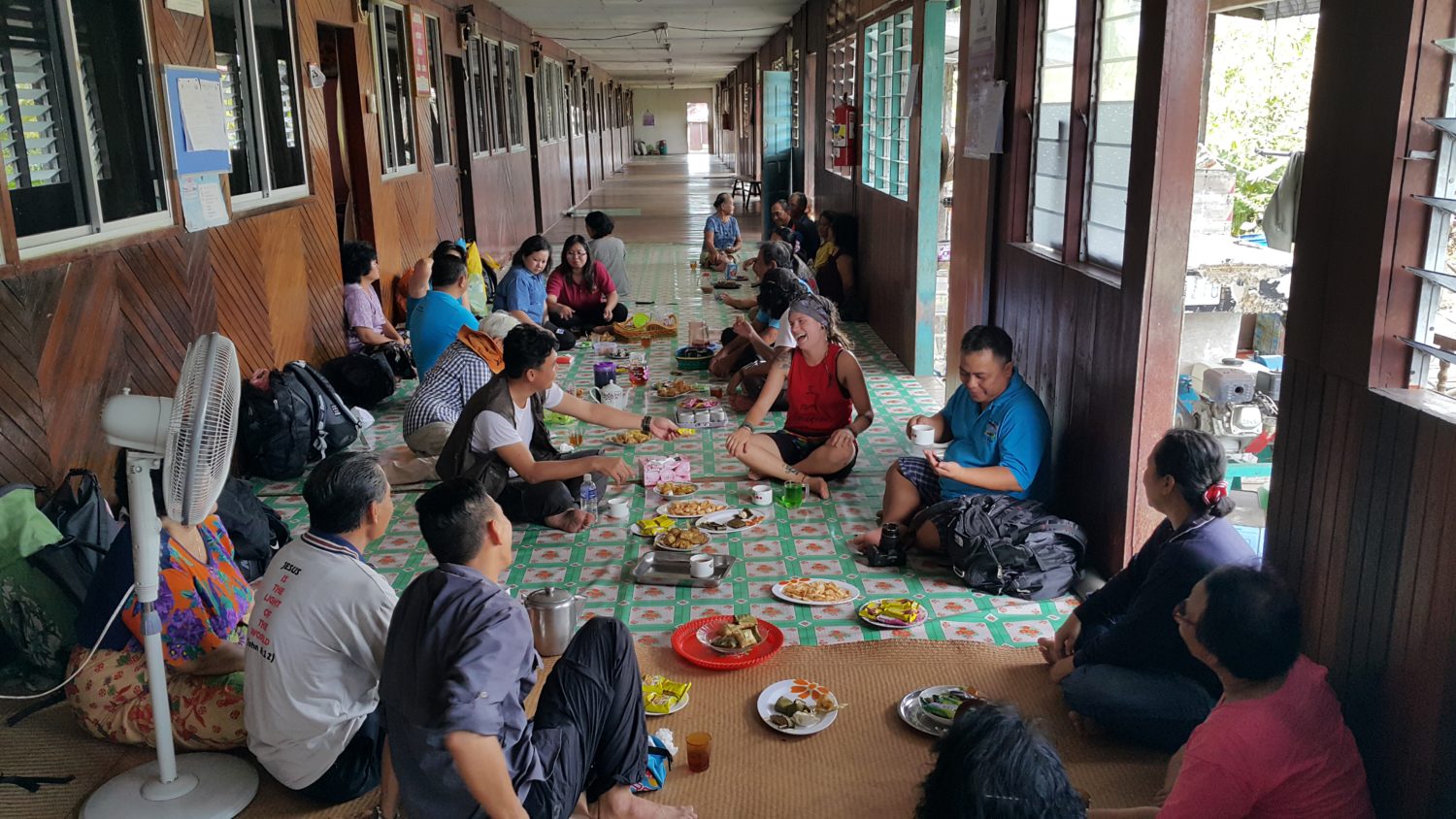
12. Get Festive
If you try to make it round every festival in the Sarawak calendar, you are certain to fail. Sometimes two or three take place in a week, celebrating music, dance, art, culture, tattooing, food, faith, fruit and even natural features. From giant extravaganzas that occupy the entire Kuching Waterfront to mini-fetes in alleyways and shopping centre atria, there is always something going on in Sarawak on any given day.
Faith-based holidays create an ongoing annual round of festival fun. From the whizz-bang of fireworks and crackers throughout the fifteen days of Chinese New Year to gigantic Christmas parades, they are an inbuilt Sarawak excuse to meet up with friends and family and watch the festivities go by. Family members will often fly in from around the world for reunion dinners, celebratory lunches and binge breakfasts and the town will truly hop throughout the festival period.
As if that is not enough, Sarawak stages several events in its pursuit of a party. Music is a big festival draw in many different forms. The Granddaddy is the Rainforest World Music Festival drawing massive crowds to the Sarawak Cultural Village in July every year to watch bands from all around the world thump out traditional tunes into the rainforest air. But other genres also take their turn. Jazz is up and coming in both Miri and Kuching and Sibu stages the Borneo Cultural Festival with local music and dance. Once a year, the sleepy town of Siniawan comes alive with Country and Western rhythms as all the Bau cowboys strut their stuff.
Other aspects of Sarawak culture also take their turn. Rainforest Fringe Festival revs up for the Rainforest World Music Festival the following week with a packed programme of talks, exhibitions, shows and events, while What about Kuching runs the whole month of October – a festival by the community for the community in which Kuching’s creative groups put on their own events for anyone who wants to attend. Food is a big favourite, with August’s Kuching Festival, an established eating marathon, featuring the best of Sarawak street food. Even the mooncake gets its own multi-cultural street fair the following month.
Sarawak’s natural features also get a look in, like at the Benak festival where the residents of Sri Aman and beyond gather once a year to collectively admire the town’s biggest tidal bore, the giant wave that sweeps up the Batang Lupar twice a day, sometimes carrying surfers in its wake. With each event accompanied by handicraft markets, mini music parties, feasting and drinking, it is sometimes more of a challenge in Sarawak to get a little rest from being festive.

13. Sing your heart out
Sarawakians love to sing! It’s a Southeast Asian thing, famous in the Philippines where almost everyone seems to be a born diva and also evidenced in the thriving Indonesian music scene. Here in Sarawak, the East Asian Karaoke craze has never abated. In fact, it goes from strength to strength, buoyed by soft metal classics, Malay ballads and, most importantly, by an incredible indigenous pop music movement.
Often in Iban, it is a prime example of the music of Nusantara, blending joget rhythms with the modern sounds of island Southeast Asia. There is a massive body of melodies and everyone seems to know them. As soon as the opening strains of ‘Biar Bekikis Bulu Betis’ strike up, the formerly reserved audience will rise up as one and start singing along. This is arguably the song with the world’s most unusual lyrics, telling the plight of a man who would rather shave his feet than lose the woman of his dreams. Apparently, this references an old established taboo against excessive depilation, allowing for the ultimate Iban extension to Meatloaf’s “I would do anything for love”!
Darkened karaoke bars have a full list of indigenous pop classics for enthusiasts to harmonise with, along with the additional treat of watching the classic videos that accompany them, though you can always opt for the Meatloaf melody instead. Even better is attendance at any event in any village throughout the state where karaoke, often to a local kampung band, is a staple. Here you might find yourself hauled up to sing for Suara Emas (the Golden Voice) where sponsors will pay for the privilege of hearing your efforts. It is all in good part and no one will judge you, even if they are all experts at singing their hearts out. So you might as well sing yours out too!
14. Get decorative
If you wander down Main Bazaar or round the markets at any event, you can’t miss the Sarawak handicrafts. They come in a whole range of items from woven mats, blankets and baskets, carved curios, embroidered cloths, beaded jewelry and fired ceramics. These are, of course, part of the tourist trade but also all authentic evidence of the multiple Sarawak cultures that make up the state and, often, of the nature that surrounds them. Many of these pieces have been made for centuries in service of a life in the jungle, serving ritual and practical purposes and defining the Sarawak space.
Most are made from the natural materials so abundant in the state – rattan, reeds, timber, tree bark and clay. Traditionally, very few were art for art’s sake, employed instead in a range of duties from carrying heavy loads through the rainforest to preparing padi for harvest. So any purchase you make in Sarawak can serve as a reminder of a place and also an entire way of life. But, this does not mean that these items are not also artistic. The Borneo motifs that cover them convey both beauty and meaning, distinctive swirling designs that depict flora and fauna, both actual and mythical, and almost all of them tell a story if you know how to read them; the stories of Gods and monsters, of heads taken and lost, of wanderings in the great forests of Borneo.
Actually, one of the most famous expressions of the Borneo motif is probably etched on the skin. The Sarawak tattoo is an ancient practice that evoked magic, power, protection and identity and, after a brief period of decline, it is now enjoying resurgence, both locally and internationally. Many Sarawakians of all ages sport ink on their skin and Sarawakian artists are taking up world tours to demonstrate the traditional art of the hand-tap tattoo. If you already have ink or aspire to it, then there is no badge of honour greater than a Borneo tattoo done right here in its home.
In fact, Borneo art and culture as a whole is enjoying a renaissance. The motifs and their meanings are being reclaimed and reinvented for a modern world and modern media is creating a new era in Borneo-based design. Many products in the state are still handmade since mass production came relatively late to Sarawak; most people were still making their own clothes until well into the 70s. So it is this combination of artisanal skills and an inventive eye that is driving the movement. A walk round central Kuching will yield up haberdashers, bead suppliers and fabric shops aplenty, as well as tailors and tinsmiths still plying their trade. If you are already artistic, there is so much to inspire you. If not, it is a safe space to invent and, ultimately, to enjoy getting decorative.
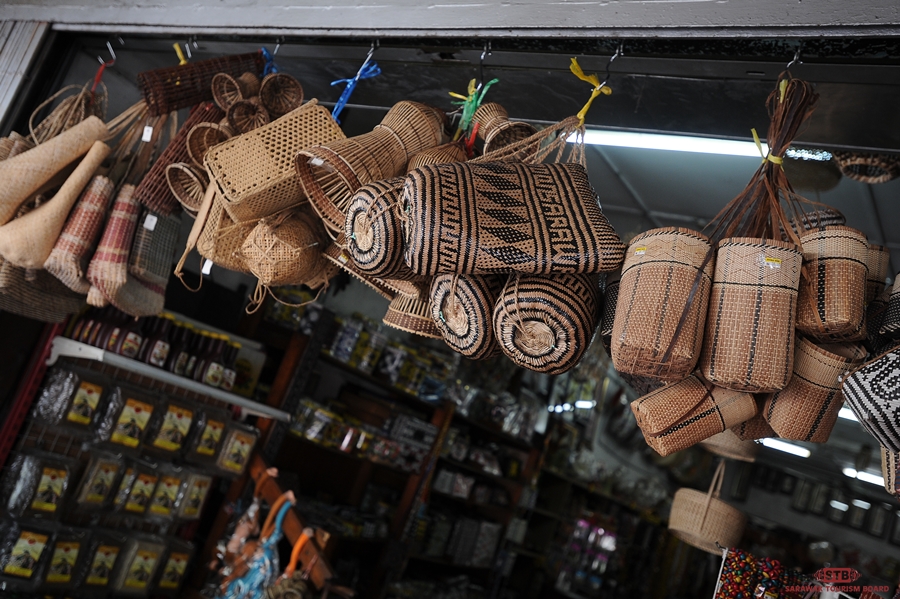
15. Marvel at the monsoon
Most tourists avoid inclement weather, seeking sunnier climes for their brief escape from everyday life. But when you live just a few degrees north of the equator, all weather bets are off. Every day is hot and humid in some combination and, in fact, many locals long for rain. And why not when the rains are as spectacular as the tropical thunderstorms that sweep across Sarawak at the end of the year?
It all follows a predictable pattern. The sky darkens menacingly, the wind whips up, a few scattered raindrops transform into a torrential downpour. Storm drains overflow and people scurry for cover. Transit stops as the coffeeshops become a temporary shelter for everyone to sit back and relax as they wait for it to pass, talking loudly through the thunderous noise of the raindrops striking the tin roofs overhead. In fact, there is nothing more comforting than being indoors when the tropical rain falls outside. When it is all over, and it usually passes quickly, the crowd disperses into the cool of the evening and life carries on.
The second reason to come to Sarawak in the rainy season is also climate controlled. With the tropical seasonal round, the rains mean fruit and masses of it. As the most iconic fruit in Southeast Asia, the King is the durian and Borneo is its ancestral home. With more species than anywhere else in the region, it is now believed that durian is indigenous to this island and migrated out. The indigenous people of Sarawak have eaten it for centuries, tending vast orchards passed down through the generations. At the end of the year, piles of the famously pungent fruit come down from the mountains filling the town with its distinctive stink. The locals love it and the true Sarawak experience is to squat by the roadside sellers and sample its delights!
It doesn’t stop there either as mounds of tropical fruit fill the markets – mangosteen, langsat, rambutan and longan – as well as Sarawak’s delicious dabai, which looks like an olive but tastes more like avocado. So it is that Sarawak is an all-weather experience. In fact, any time of year, there is something special about staring at a Sarawak sky as it transitions from cerulean blue to indigo storm setting to technicolour sunset to starry, starry night. So consider braving the December rains to marvel at the Sarawak monsoon.
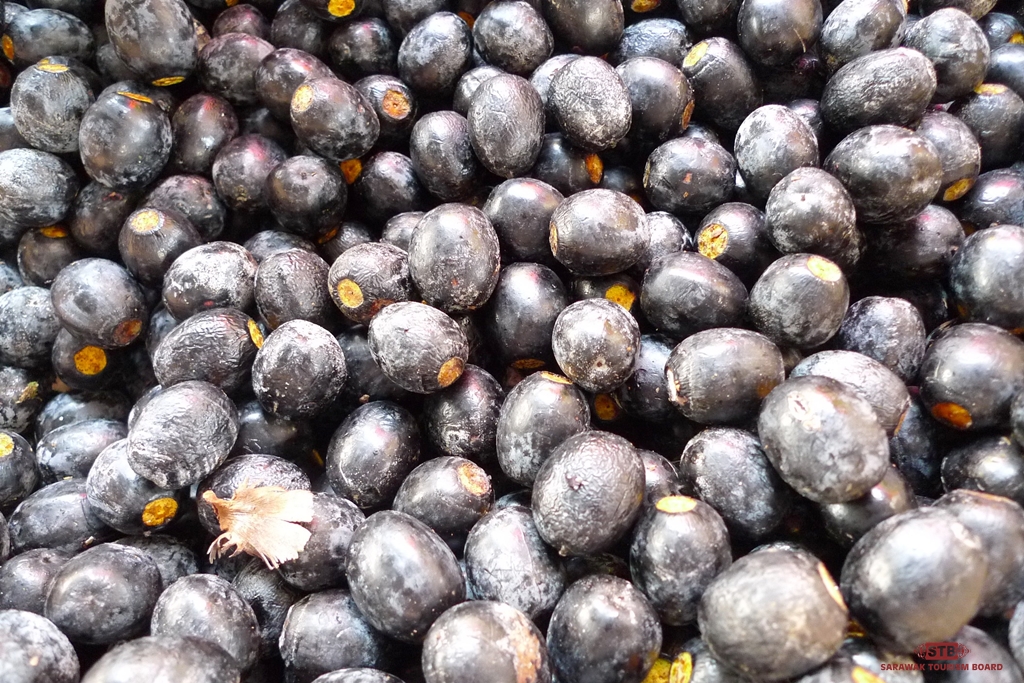
Dabai

